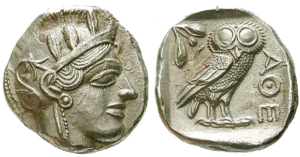ATHENA’S FEATHERED FRIEND
 Long before mascots and logos, the owl represent not only the city of Athens but the concepts of wisdom and prosperity as well. This owl has been a defining future of the Acropolis in the city of Athens for centuries. Some romantic accounts have its distant ancestors roosting in the high rafters of the original Parthenon, before it was burned by the Persians in 480 BC, to be replaced by the more familiar marble temple that stands on the Acropolis today.
Long before mascots and logos, the owl represent not only the city of Athens but the concepts of wisdom and prosperity as well. This owl has been a defining future of the Acropolis in the city of Athens for centuries. Some romantic accounts have its distant ancestors roosting in the high rafters of the original Parthenon, before it was burned by the Persians in 480 BC, to be replaced by the more familiar marble temple that stands on the Acropolis today.
In the classical times, the owl was the emblem of the city of Athens. It was the sacred bird of the goddess Athena, the city’s patron deity. Vase paintings, statues and reliefs often show Athena in the company of an owl, which sometimes flies around her and at other times sits on her shoulder, imparting its counsel. In addition to being a fierce protectress of the city, Athena was the goddess of wisdom and the owl was the embodiment of her intellectual powers.
Nobody knows exactly how this association came about. Some say it was either the owl’s human-like gaze or its ability to see in the dark that gave the bird it’s reputation for wisdom. Others suggest that the roots of this connection lie deep in prehistoric myth, hinted at by early images of female divinities in the company of birds. To this day, the little owl (Athena noctua) owes its scientific name to its relationship with the goddess Athena.
In classical times, Athens owed its wealth to the silver extracted from the mines of Lavrion, located on the coast southeast of the city. The Athenian tetradrachm, the four drachma coin, was imprinted on one side with the image of Athena and on the other with an owl and an olive branch, Athena’s fruitful gift to the city.
In classical times, Athens owed its wealth to the silver extracted from the mines of Lavrion, located on the coast southeast of the city. The Athenian tetradrachm, the four drachma coin, was imprinted on one side with the image of Athena and on the other with an owl and an olive branch, Athena’s fruitful gift to the city.

The coin was known colloquially as a glaux /glafx/ (little owl), and was the reserve currency of the ancient world. The current one-euro coins minted in Greece bear the same motif of the glaux as the ancient Athenian coin. They owl’s association with money is also where the ancient expression “owls to Athens” is thought to originate: like the English equivalents, “coals to Newcastle” or “ice to the Eskimos”, it means “to offer someone what they have in abundance” and is shorthand for the pointless gesture, or a statement of the obvious.

